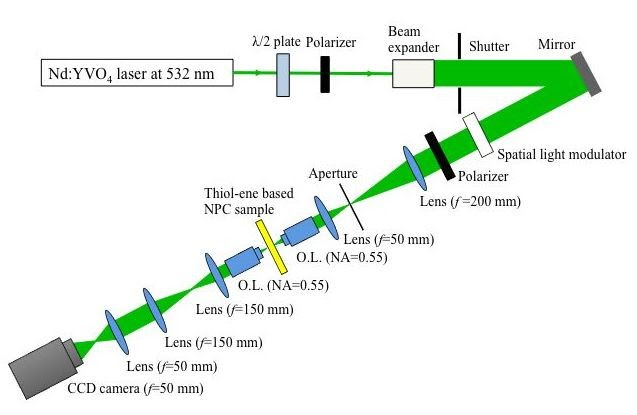10 March 2017
Holograms offer a means of increasing data storage density that may help to meet the demands of ever decreasing device sizes and increasing memory requirements. Kohta Nagaya, Eiji Hata and Yasuo Tomita at the University of Electro-Communications in Japan demonstrate that coaxial holographic digital data storage in a thiol-ene based nanoparticle-polymer composite can achieve competitive symbol error rates and signal-to-noise ratios.
Using changes in refractive index to optically record data, holograms record in three dimensions instead of being limited to the surface alone, thereby increasing the amount of data recorded. To diminish symbol error rates and increase signal-to-noise ratios the recording material must undergo large refractive index changes with a high recording sensitivity and be resilient to shrinkage during the process.
Inorganic nanoparticle-polymer composites are excellent candidates for meeting holographic data storage criteria, and the UEC researchers have already demonstrated holographic storage in nanoparticle-polymer composites by use of thiol and ene-monomers, 'so-called thiol-ene monomers'. By shifting the storage medium within a few tens of micron-size beam spot during the recording process holographic shift-multiplexing storage was achieved.
Now the UEC researchers have demonstrated co-axial holographic data storage in thiol-ene based nanoparticle-polymer composites. Coaxial data recording positions the reference beam around the signal beam and has been proposed as a means of increasing data density and transfer rates for a more competitive data storage technology.
The researchers used silica nanoparticles uniformly dispersed to secondary thiol and an allyl triazine triene monomer components. Optimum symbol error rates (less than 10-4) and signal-to-noise ratios (higher than 10) were achieved when silica nanoparticles were used at 25 vol.% concentrations and the composition of thiol-ene monomers was stoichiometric.
The researchers conclude, "These results show the usefulness of thiol-ene based nanoparticle-polymer composites as coaxial holographic data storage media."
Reference
Kohta Nagaya, Eiji Hata, and Yasuo Tomita, Readout fidelity of coaxial holographic digital data page recording in nanoparticle-(thiol-ene) polymer composites, Jpn. J. Appl. Phys. 55 09SB03 (2016).
Department of Engineering Science, University of Electro-Communications, Chofu, Tokyo 182-8585, Japan















